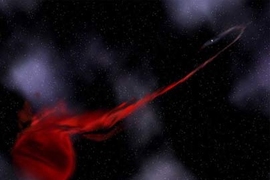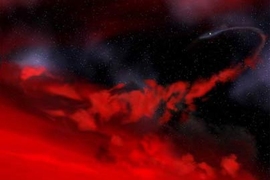MIT astronomers played a key role in discovering what NASA calls one of the most bizarre objects in space: a star "skeleton" of very low mass that is orbiting and being slowly consumed by a pulsar, or remains of a second massive star, that is itself spinning faster than a kitchen blender.
A NASA team led by Hans Krimm and Craig Markwardt at Goddard Space Flight Center and an MIT team led by Deepto Chakrabarty, an associate professor of physics in MIT's Kavli Institute for Astrophysics and Space Research, described the overall system (known by its abbreviation SWIFT J1756.9) in an article accepted for publication in the Astrophysical Journal Letters.
"While we already know of several cases of pulsars that have consumed or vaporized most of the mass in their companion star, SWIFT J1756.9 is possibly the most extreme example," said Chakrabarty.
Systems like SWIFT J1756.9 provide a rare opportunity for astronomers to examine how millisecond pulsars are spun up to such incredibly rapid speeds, and to determine their eventual fate, he added.
SWIFT J1756.9 was discovered earlier this year using NASA's Swift and Rossi X-Ray Timing Explorer (RXTE) satellites. The RXTE observations indicate that the pulsar, a type of neutron star, is spinning 182.07 times per second, even though it is believed to contain at least 1.4 times the mass of the sun but is only about 10 miles across. "This means that the surface of the star is moving at about 7000 miles per second, or roughly 4 percent the speed of light," Chakrabarty said.
The companion object was found to orbit the pulsar every 54.7 minutes at an average distance of only about 230,000 miles (slightly less than the distance from Earth to the moon). It has what astronomers consider a very low mass: about seven times that of Jupiter. For comparison, the sun is over 1000 times more massive than Jupiter.
"This object is merely the skeleton of a star," says Markwardt. "The pulsar has eaten away the star's outer envelope, and all that remains is its helium-rich core."
The system is only the eighth millisecond pulsar observed to be pulling mass from a companion, and only one other such system has a companion with such a low mass. The companion in that system also has a minimum mass of about seven Jupiters.
The system probably formed several billion years ago, when it consisted of a very massive star and a smaller star. The more massive star evolved quickly and exploded as a supernova, leaving behind a pulsar. The smaller star eventually started to puff up as it aged, and the two objects became embedded in the extended stellar envelope. This drained orbital energy, causing the two stars to draw ever nearer.
Today, the two objects are so close to each other that the pulsar's powerful gravity produces a tidal bulge on its companion, siphoning off gas that flows into a disk that surrounds the pulsar. The flow eventually becomes unstable and dumps large quantities of gas onto the pulsar, causing an outburst like the one observed in June.
With an estimated distance of roughly 25,000 light-years, the system is normally too faint to be detected, and is only visible during an outburst. SWIFT J1756.9 has never been seen to erupt until this June, so as Markwardt points out, "We don't know how long it will slumber before it wakes up again."
In addition to Chakrabarty, the MIT team includes Jacob Hartman, a graduate student in physics who defended his Ph.D. thesis on August 2.
A version of this article appeared in MIT Tech Talk on September 19, 2007 (download PDF).









